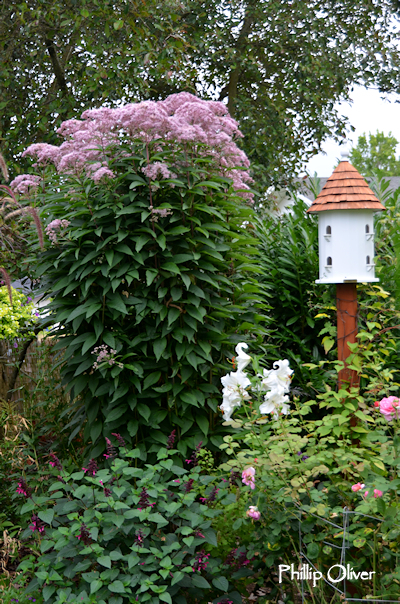The Garden House (Devon, England)
The destinations are beginning to blur but looking at the tour guide booklet, I see that we are now in Plymouth. Today, we visited two gardens designed by Keith Wiley. The first is The Garden House , where Wiley worked as Head Gardener for 25 years (from 1978-2003). The 10-acre estate was purchased in the 1940s by former Eton schoolmaster Lionel Fortescue and his wife Katherine. It was formerly home to the vicars of Buckland Monachronum. The Fortescue's renovated the gardens and ran a market garden business and raised cattle. The remains of some of the original buildings in the vicarage still stand in the garden and serve as a romantic backdrop in the Walled Garden - I loved the way they had massed ferns together. Just stunning! Surrounding the walled garden and venturing out away from the house are more naturalistic plantings - Today, the head gardener is Nick Haworth, who was previously head gardener at Greenway , which we visited earlier. Keith Wiley lef...




That's quite a dramatic difference. You are very brave. I hope it works.
ReplyDeleteI tend to do this with Aster, that often gets too tall for my liking and tend to plop over with autumn rains and winds. I remove a third off the top, and get shorter but fuller blooms.
ReplyDeleteYou must submit another photo of this eager shrub, once it starts blooming.
Asters was one of the plants that was mentioned as a good candidate.
DeleteBeautiful plant. Do you know if the cut stalks will multiply/branch off? Just this morning I cut back my returning pineapple sage, which I *love*, but it gets so leggy late in the season. I'm hoping it will not only stay neat but have more branches and flowers.
ReplyDeleteLook forward to seeing how it turns out.
ReplyDeleteI've been doing something similar this year with some of my perennials -- none that get that tall -- including some goldenrod and Coreopsis pubescens. The Coreopsis is just starting to bloom now so I'm looking forward to seeing whether I like the effect.
(I think cutting in layers or doing the Chelsea Chop can also increase the number of flowers, since often the cut stem will branch. I've done that quite successfully in the past with the 'standing cypress' wildflower, for instance.)
Aaron, yes I also sheared back my goldenrod.
DeleteYou must have the straight species. It is a beauty for sure. It will do just fine no doubt. Can't wait to see it when it blooms. I chopped my sedums due to their floppy nature. They aren't in full sun unfortunately. It isn't their fault. The chop does help.
ReplyDeleteThat is great to hear!
DeleteEither way that's a beautiful scene, with the birdhouse and the bit of natural fencing as accent to the shrubbery.
ReplyDeleteI chop asters and Autumn Joy sedum so they don't flop. I also thin asters and phlox to reduce powdery mildew.
ReplyDeleteTracy, that reminds me to do that to my sedum! Thanks
DeleteWould love to have an update! How did they do?
ReplyDeleteI Chelsea Chop the outer ring of my large Culver's Root plant. The shorter plants help keep the tall inner section from flopping over and this year bloomed right when the inner section was finished. The bumblebees were very pleased!
ReplyDelete